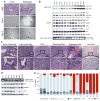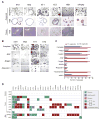Organoid models of human and mouse ductal pancreatic cancer
- PMID: 25557080
- PMCID: PMC4334572
- DOI: 10.1016/j.cell.2014.12.021
Organoid models of human and mouse ductal pancreatic cancer
Abstract
Pancreatic cancer is one of the most lethal malignancies due to its late diagnosis and limited response to treatment. Tractable methods to identify and interrogate pathways involved in pancreatic tumorigenesis are urgently needed. We established organoid models from normal and neoplastic murine and human pancreas tissues. Pancreatic organoids can be rapidly generated from resected tumors and biopsies, survive cryopreservation, and exhibit ductal- and disease-stage-specific characteristics. Orthotopically transplanted neoplastic organoids recapitulate the full spectrum of tumor development by forming early-grade neoplasms that progress to locally invasive and metastatic carcinomas. Due to their ability to be genetically manipulated, organoids are a platform to probe genetic cooperation. Comprehensive transcriptional and proteomic analyses of murine pancreatic organoids revealed genes and pathways altered during disease progression. The confirmation of many of these protein changes in human tissues demonstrates that organoids are a facile model system to discover characteristics of this deadly malignancy.
Copyright © 2015 Elsevier Inc. All rights reserved.
Conflict of interest statement
Conflicts of interest:
Dr. Ralph Hruban receives royalty payments from Myriad Genetics for the PalB2 inventions.
Dr. Hans Clevers and Meritxell Huch have patents pending and granted on the organoid technology.
Figures







Comment in
-
Pancreatic cancer: From normal to metastases--a whole gamut of pancreatic organoids.Nat Rev Gastroenterol Hepatol. 2015 Feb;12(2):61. doi: 10.1038/nrgastro.2015.1. Epub 2015 Jan 20. Nat Rev Gastroenterol Hepatol. 2015. PMID: 25601668 No abstract available.
References
-
- Agbunag C, Bar-Sagi D. Oncogenic K-ras drives cell cycle progression and phenotypic conversion of primary pancreatic duct epithelial cells. Cancer research. 2004;64:5659–5663. - PubMed
-
- Barker N, Huch M, Kujala P, van de Wetering M, Snippert HJ, van Es JH, Sato T, Stange DE, Begthel H, van den Born M, et al. Lgr5(+ve) stem cells drive self-renewal in the stomach and build long-lived gastric units in vitro. Cell Stem Cell. 2010;6:25–36. - PubMed
Publication types
MeSH terms
Grants and funding
- 5P50CA101955-07/CA/NCI NIH HHS/United States
- CA101955/CA/NCI NIH HHS/United States
- P20 CA101955/CA/NCI NIH HHS/United States
- P50 CA062924/CA/NCI NIH HHS/United States
- 1U10CA180944-01/CA/NCI NIH HHS/United States
- CA134292/CA/NCI NIH HHS/United States
- CA62924/CA/NCI NIH HHS/United States
- R01 CA190092/CA/NCI NIH HHS/United States
- P01 CA134292/CA/NCI NIH HHS/United States
- 1R01CA190092-01/CA/NCI NIH HHS/United States
- P50 CA101955/CA/NCI NIH HHS/United States
- 5T32CA148056/CA/NCI NIH HHS/United States
- P30 CA008748/CA/NCI NIH HHS/United States
- 5U01CA168409-3/CA/NCI NIH HHS/United States
- 5P30CA45508-26/CA/NCI NIH HHS/United States
- U10 CA180944/CA/NCI NIH HHS/United States
- P30 CA045508/CA/NCI NIH HHS/United States
- U01 CA168409/CA/NCI NIH HHS/United States
- F32 CA180717/CA/NCI NIH HHS/United States
- 104151/Wellcome Trust/United Kingdom
- 5P30CA045508/CA/NCI NIH HHS/United States
- T32 CA148056/CA/NCI NIH HHS/United States
LinkOut - more resources
Full Text Sources
Other Literature Sources
Medical
Molecular Biology Databases

